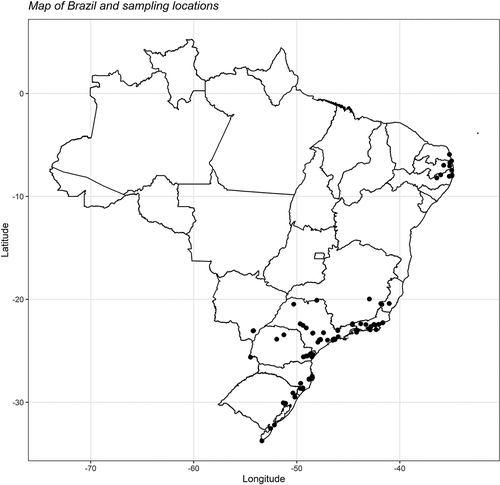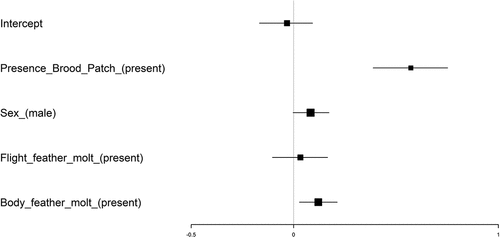Figures & data
Figure 1. Map of Brazil and the capture sites of all 2,127 individuals belonging to 21 tanager species (Passeriformes: Thraupidae) incorporated in this study. The black dots on the map denote the sampling locations. Detailed information regarding each location site and the number of captured individuals per species is provided in Supplementary Table 6 for comprehensive reference.

Table 1. Summary data of 953 female individuals belonging to 21 tanager species. Here I show the number of females per species, detailing the total count of captures (N), the number of females undergoing flight feather moult (FM), body moult (BM), or both, categorised by the presence or absence of a brood patch.
Figure 2. Results of the phylogenetic generalized linear mixed model (PGLMM) examining body condition in 2,127 individuals belonging to 21 tanagers species. The PGLMM model had body condition as the response variable, and the presence of a brood patch (reference level: absent), sex (reference level: female), flight feather moult (reference level: absent), and body feather moult (reference level: absent) as predictors. The tanager phylogeny was included in the model to account for species-relatedness. I also included the latitude, longitude, Brazilian state, and year as random terms, to account for potential spatial-temporal variability in the model. Here, I show the 95% confidence intervals (C.I.), with the black box indicating the average C.I., and the straight line indicating the lower (beginning) and upper (end) C.I. Results indicate that females with a brood patch have a higher body condition compared to females without a brood patch and that individuals moulting the body feathers also had a higher body condition compared to non-moulting individuals.

Table 2. Results of the Phylogenetic Generalized Linear Mixed Model (PGLMM) of 2,127 individuals belonging to 21 tanager species with body condition as the response variable, while predictors included sex, presence of body feather moult, flight feather moult, and breeding status. I present fixed-term effects, along with estimates, standard errors (SE), 95% confidence intervals (95% C.I.), and corresponding p-values. Random-effect terms (longitude, latitude, Brazilian, state, breeding season, and year) are delineated by variance and standard deviations. A phylogenetic effect was also taken into consideration to account for species relatedness (phylogenetic effect), showing the variance and standard deviation of the species effect within the model.
Supplemental Material
Download MS Word (238.3 KB)Data availability statement
The dataset is available in the literature (Rodrigues et al. Citation2019), while the corresponding R code can be accessed from the GitHub repository at https://github.com/victoraspenha/body-condition-in-tanagers.
